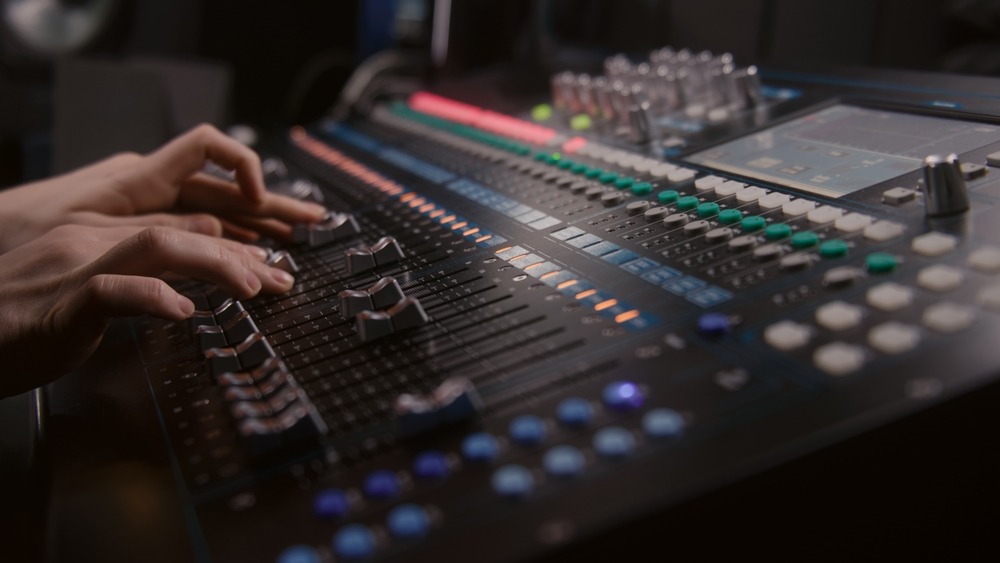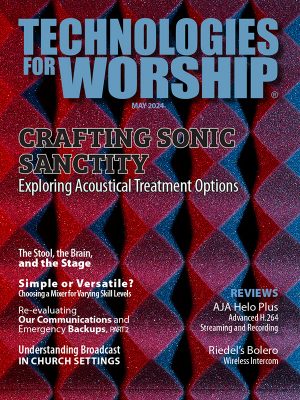
Creating the right ambient noise in your worship livestream can elevate the experience for your online congregation, making it feel more immersive and genuine. Ambient noise, when used effectively, can replicate the atmosphere of in-person services, making remote worshippers feel more connected to the community.
The Importance of Ambient Noise in Worship Livestreams
Ambient noise encompasses the subtle background sounds that naturally occur in a space. In a worship setting, these might include the murmur of the congregation, the rustling of pages, or the soft echo of footsteps. While these sounds may seem insignificant, they contribute to the overall worship experience by reinforcing the sense of being present in a sacred space.
Without ambient noise, a livestream can feel sterile and disconnected. Viewers may feel like they’re watching a performance rather than participating in a worship service. Incorporating ambient sounds can help bridge this gap, making the experience more relatable and engaging.
Creating the right ambient noise in your worship livestream can elevate the experience for your online congregation, making it feel more immersive and genuine. Ambient noise, when used effectively, can replicate the atmosphere of in-person services, making remote worshippers feel more connected to the community.
Types of Ambient Noise to Consider
- Congregational Sounds: The collective murmur of voices before the service starts, the sound of people settling into their seats, or even the occasional cough can add to the authenticity of the experience.
- Instrumental and Choir Sounds: If your service includes live music, consider capturing not just the main performance but also the background sounds of musicians preparing, choir members humming softly, or the tuning of instruments. These sounds add a layer of depth and realism.
- Natural Acoustics: Every worship space has its unique acoustics. The way sound reverberates in a large cathedral versus a small chapel can be very different. Capturing these natural acoustics can help convey the grandeur or intimacy of the space.
- Outdoor Sounds: If your service occasionally takes place outdoors, the sounds of nature—birds chirping, wind rustling through leaves, or distant traffic—can enhance the worship experience by reminding viewers of the broader world.
Techniques for Capturing Ambient Noise
Effectively capturing ambient noise requires a combination of the right equipment, strategic placement, and thoughtful mixing. Below are several techniques to help you achieve the best results in your worship livestream.
Microphone Placement
The placement of microphones is critical in capturing the desired ambient noise without overwhelming the primary audio. Here are a few strategies you should consider:
- Near the Congregation: Positioning microphones within or near the congregation can capture the collective murmur, rustling of pages, and other subtle sounds that contribute to the atmosphere. These sounds can be blended softly into the main audio to create a sense of presence.
- At the Back of the Worship Space: Placing microphones at the rear of the room helps capture the overall acoustics of the space, including how the main audio (like sermons or music) reverberates. This can provide a fuller, richer sound that mirrors the in-person experience.
- Overhead Microphones: Suspended or overhead microphones can be used to capture a broad spectrum of ambient noise from a higher perspective. This can be particularly effective in large spaces where you want to capture a blend of congregational sounds and natural acoustics.
- Near Instrumentalists and Choir: If your service includes live music, placing microphones near the instrumentalists and choir can pick up the subtle sounds of tuning instruments, soft humming, and shuffling. These sounds add depth and warmth to the audio experience.
- Directional Microphones: For capturing specific ambient sounds without picking up too much noise, consider using directional microphones. These can be aimed at a particular area, such as a choir section or an open window with outdoor sounds, to isolate and capture those specific elements.
Sound Mixing
Balancing ambient noise with primary audio is crucial for creating a cohesive soundscape that enhances the worship experience. Here’s how to achieve that balance:
- Layering Sounds: In the sound mixing process, ambient noise should be layered under the primary audio, such as sermons or hymns. This layering creates a more immersive experience without overpowering the main content.
- Volume Control: Adjust the volume of the ambient noise to ensure it’s present but not distracting. For instance, the sound of a congregation murmuring should be subtle enough that it adds to the atmosphere without drawing attention away from the sermon.
- Use of Equalization (EQ): Use EQ to adjust the frequencies of the ambient noise. For example, you might want to reduce low-end rumble or enhance the midrange to make certain ambient sounds more prominent. This helps in blending the ambient noise seamlessly with the main audio.
- Automation in Mixing: Utilize automation tools in your mixing software to dynamically adjust the levels of ambient noise throughout the service. For instance, you might want to bring up the ambient sound during quiet moments or fade it out when the sermon begins.
Capturing Outdoor Ambient Sounds
Outdoor services or those that incorporate elements of nature can benefit greatly from capturing ambient sounds like birdsong, wind, or distant traffic. Here’s how to do it effectively:
- Outdoor Microphones: Use microphones designed for outdoor recording, which are better equipped to handle elements like wind and environmental noise. These microphones should be placed strategically to capture the desired sounds without picking up too much extraneous noise.
- Windshields and Windjammers: To reduce wind noise, use windshields or windjammers on your outdoor microphones. This ensures that the natural sounds are captured clearly without the distracting rumble of the wind.
- Blend with Indoor Sounds: If your service transitions between indoor and outdoor settings, ensure that the ambient sounds blend smoothly. This may require careful sound mixing to ensure that the transition feels natural and unintrusive.
- Incorporate Outdoor Sounds in Indoor Services: Even if your service is entirely indoors, consider incorporating outdoor ambient sounds (such as a soft rain or distant birdsong) to create a more dynamic and engaging atmosphere.
By employing these techniques, you can capture and integrate ambient noise into your worship livestream in a way that enhances the overall experience. Whether you’re dealing with the natural acoustics of a cathedral or the gentle rustle of leaves in an outdoor service, careful attention to ambient sound can make your livestream feel more authentic and immersive for all who participate.
Potential Pitfalls and How to Avoid Them
While incorporating ambient noise into your worship livestream can greatly enhance the viewing experience, it also comes with potential challenges. To ensure the best outcome, it’s important to be aware of common pitfalls and take steps to avoid them.
Overpowering Main Audio
One of the most common issues with ambient noise is that it can sometimes overpower the primary audio content, such as sermons, prayers, or music. This can make it difficult for viewers to focus on the key elements of the service, leading to a less engaging experience. Here’s what can help avoid this.
- Careful Sound Mixing: Ensure that the ambient noise is mixed at a lower volume than the primary audio. The goal is for the ambient sound to be a subtle background layer, enhancing the main content without distracting from it. During quieter moments, you can slightly increase the ambient sound level, but always keep it secondary to the main audio.
- Regular Monitoring: Have a dedicated team member monitor the audio levels throughout the service. This person can make real-time adjustments if the ambient noise becomes too prominent or if there’s a sudden increase in unwanted background noise.
- Automation Tools: Use automation tools in your audio mixing software to control the levels of ambient noise dynamically. For example, set the ambient noise to fade out automatically when the sermon starts and gradually fade in during pauses or transitions.
Unwanted Sounds
Not all ambient noise is beneficial. Sounds such as loud coughing, babies crying, doors slamming, or excessive chatter can be distracting and detract from the worship experience. These unwanted sounds can become more pronounced in a livestream, where the audio is captured more directly.
You can avoid unwanted sounds by following these tips:
- Microphone Positioning: Place microphones strategically to minimize the pickup of unwanted sounds. For instance, avoid placing mics near doors, children’s areas, or places where people frequently move about. Directional microphones can help isolate desired sounds while reducing the pickup of distracting noises.
- Noise Gates and Filters: Use noise gates and filters in your audio processing to eliminate or reduce unwanted sounds. A noise gate can automatically mute the microphone when the sound level falls below a certain threshold, reducing the impact of sudden loud noises.
- Audience Guidelines: If possible, provide gentle guidelines to the congregation before the service begins, encouraging them to minimize unnecessary noise. This might include reminders about silencing cell phones, keeping conversations to a minimum, or being mindful of their surroundings.
Technical Issues
Capturing and integrating ambient noise effectively requires technical expertise and the right equipment. Poorly configured equipment or lack of technical know-how can result in subpar audio quality, leading to issues like feedback, distortion, or unbalanced sound.
Avoid this happening by:
- Investing in Quality Equipment: Ensure that you have high-quality microphones, audio interfaces, and mixing software. While it’s possible to start with basic equipment, investing in good-quality gear will make a noticeable difference in the clarity and balance of your audio.
- Providing Professional Training: Provide training for your audio team on how to capture and mix ambient noise effectively. Understanding the basics of acoustics, microphone types, and sound mixing techniques is essential for producing high-quality audio.
- Doing Test Runs: Conduct test runs before the actual service to identify any potential issues with the audio setup. This can help you catch problems like microphone placement, unwanted noise, or technical glitches before they affect the livestream.
- Having Backup Systems: Always have backup equipment and a contingency plan in place in case of technical failures. This could include having spare microphones, cables, or even a secondary recording device ready to go.
Inconsistent Ambient Noise
Inconsistent ambient noise can create a disjointed audio experience for viewers. For example, if the level or quality of ambient noise changes abruptly during the service, it can be jarring and pull the audience out of the moment.
You can mitigate this issue with:
- Consistent Microphone Placement: Ensure that microphones are placed consistently for each service, capturing ambient noise from the same locations. This helps maintain a steady ambient sound profile throughout the livestream.
- Use of Ambient Noise Loops: If live ambient noise is inconsistent or unpredictable, consider using pre-recorded ambient noise loops. These can provide a consistent background atmosphere, especially during moments when live ambient noise is insufficient.
- Real-Time Adjustments: Have a sound technician monitor the audio feed in real-time and adjusting as necessary. If the ambient noise becomes too quiet or too loud, they can quickly correct it to maintain consistency.
Incorporating ambient noise into your livestream is a powerful way to enhance the experience, making it feel more immersive and authentic, making remote congregants feel more connected to your worship community. By carefully selecting and mixing these sounds, you can create a more immersive and meaningful worship experience that resonates with your audience. Understanding mic placement, different techniques to capture the sound you want and how to avoid the sounds you don’t helps create a more engaging and spiritually fulfilling experience for your everyone.






